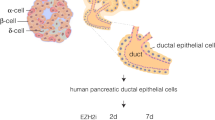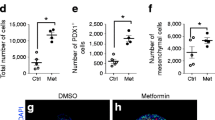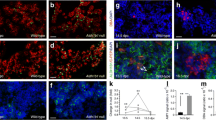Abstract
Aims/hypothesis
Aldehyde dehydrogenase 1 (ALDH1), a human stem-cell marker, is an enzyme responsible for converting retinaldehydes to retinoic acids (RAs) to modulate cell differentiation. However, data on expression levels and functional roles of ALDH1 during human fetal pancreatic development are limited. The focus of this study was to characterise ALDH1 expression patterns and to determine its functional role in islet cell differentiation.
Methods
The presence of ALDH1 in the human fetal pancreas (8–22 weeks) was characterised by microarray, quantitative RT-PCR, western blotting and immunohistological approaches. Isolated human fetal islet-epithelial cell clusters were treated with ALDH1 inhibitors, retinoic acid receptor (RAR) agonists and ALDH1A1 small interfering (si)RNA.
Results
In the developing human pancreatic cells, high ALDH1 activity frequently co-localised with key stem-cell markers as well as endocrine transcription factors. A high level of ALDH1 was expressed in newly differentiated insulin+ cells and this decreased as development progressed. Pharmacological inhibition of ALDH1 activity in human fetal islet-epithelial cell clusters resulted in reduced endocrine cell differentiation and increased cell apoptosis, and was reversed with co-treatment of RAR/RXR agonists. Furthermore, siRNA knockdown of ALDH1A1 significantly decreased RAR expression and induced cell apoptosis via suppression of the phosphoinositide 3-kinase (PI3K) pathway and activation of caspase signals.
Conclusions/interpretation
Our findings indicate that ALDH1+ cells represent a pool of endocrine precursors in the developing human pancreas and that ALDH1 activity is required during endocrine cell differentiation. Inhibition of ALDH1-mediated retinoid signalling impairs human fetal islet cell differentiation and survival.










Similar content being viewed by others
Abbreviations
- ALDH:
-
Aldehyde dehydrogenase
- ATRA:
-
All-trans retinoic acid
- CDA:
-
Canadian Diabetes Association
- cRNA:
-
Complementary RNA
- DEAB:
-
Diethylaminobenzaldehyde
- NGN3:
-
Neurogenin 3
- NKX2.2:
-
NK2 homeobox 2
- NKX6.1:
-
NK6 homeobox 1
- PAX6:
-
Paired box 6
- PDX1:
-
Pancreatic and duodenal homeobox 1
- PI3K:
-
Phosphoinositide 3-kinase
- RA:
-
Retinoic acid
- RAR:
-
Retinoic acid receptor
- RXR:
-
Retinoid X receptor
- si:
-
small interfering
- TTNPB:
-
4-[(E)-2-(5,6,7,8-tetrahydro-5,5,8,8-tetramethyl-2-naphthalenyl)-1-propenyl] benzoic acid
References
Ramiya VK, Maraist M, Arfors KE, Schatz DA, Peck AB, Cornelius JG (2000) Reversal of insulin-dependent diabetes using islet generated in vitro from pancreatic cells. Nat Med 6:278–282
Marchitti SA, Brocker C, Stagos D, Vasiliou V (2008) Non-P450 aldehyde oxidizing enzymes: the aldehyde dehydrogenase superfamily. Expert Opin Drug Metab Toxicol 4:697–720
Balicki D (2007) Moving forward in human mammary stem cell biology and breast cancer prognostication using ALDH1. Cell Stem Cell 1:485–487
Ginestier C, Hur MH, Charafe-Jauffret E et al (2007) ALDH1 is a marker of normal and malignant human mammary stem cells and a predictor of poor clinical outcome. Cell Stem Cell 1:555–567
Chute JP, Muramoto GG, Whitesides J et al (2006) Inhibition of aldehyde dehydrogenase and retinoid signaling induces the expansion of human hematopoietic stem cells. Proc Natl Acad Sci U S A 103:11707–11712
Armstrong L, Stojkovic M, Dimmick I et al (2004) Phenotypic characterization of murine primitive hematopoietic progenitor cells isolated on basis of aldehyde dehydrogenase activity. Stem Cells 22:1142–1151
Hess DA, Meyerrose TE, Wirthlin L et al (2004) Functional characterization of highly purified human hematopoietic repopulating cells isolated according to aldehyde dehydrogenase activity. Blood 104:1648–1655
Hess DA, Wirthlin L, Craft TP et al (2007) Human progenitor cells rapidly mobilized by AMD3100 repopulate NOD/SCID mice with increased frequency in comparison to cells from the same donor mobilized by granulocyte colony stimulating factor. Biol Blood Marrow Transplant 13:398–411
Pearce DJ, Taussig D, Simpson C et al (2005) Characterization of cells with a high aldehyde dehydrogenase activity from cord blood and acute myeloid leukemia samples. Stem Cells 23:752–760
Corti S, Locatelli F, Papadimitriou D et al (2006) Identification of a primitive brain-derived neural stem cell population based on aldehyde dehydrogenase activity. Stem Cells 24:975–985
Cheung AM, Wan TS, Leung JC et al (2007) Aldehyde dehydrogenase activity in leukemic blasts defines a subgroup of acute myeloid leukemia with adverse prognosis and superior NOD/SCID engrafting potential. Leukemia 21:1423–1430
Gündüz E, Demirel G, Bal C, Gulbas Z (2010) Evaluation of mobilized peripheral stem cells according to CD34 and aldehyde dehydrogenase expression and effect of SSC(lo) ALDH(br) cells on hematopoietic recovery. Cytotherapy 12:1006–1012
Burger PE, Gupta R, Xiong X et al (2009) High aldehyde dehydrogenase activity: a novel functional marker of murine prostate stem/progenitor cells. Stem Cells 27:2220–2228
Capoccia BJ, Robson DL, Levac KD et al (2009) Revascularization of ischemic limbs after transplantation of human bone marrow cells with high aldehyde dehydrogenase activity. Blood 113:5340–5351
Rovira M, Scott SG, Liss AS, Jensen J, Thayer SP, Leach SD (2010) Isolation and characterization of centroacinar/terminal ductal progenitor cells in adult mouse pancreas. Proc Natl Acad Sci U S A 107:75–80
Jelski W, Zalewski B, Szmitkowski M (2008) Alcohol dehydrogenase (ADH) isoenzymes and aldehyde dehydrogenase (ALDH) activity in the sera of patients with pancreatic cancer. Dig Dis Sci 53:2276–2280
Muramoto GG, Russell JL, Safi R et al (2010) Inhibition of aldehyde dehydrogenase expands hematopoietic stem cells with radioprotective capacity. Stem Cells 28:523–534
Kim MP, Fleming JB, Wang H et al (2011) ALDH activity selectively defines an enhanced tumor-initiating cell population relative to CD133 expression in human pancreatic adenocarcinoma. PLoS One 6:e20636
Silva IA, Bai S, McLean K et al (2011) Aldehyde dehydrogenase in combination with CD133 defines angiogenic ovarian cancer stem cells that portend poor patient survival. Cancer Res 71:3991–4001
Moreb JS, Mohuczy D, Ostmark B, Zucali JR (2007) RNAi-mediated knockdown of aldehyde dehydrogenase class-1A1 and class-3A1 is specific and reveals that each contributes equally to the resistance against 4-hydroperoxycyclophosphamide. Cancer Chemother Pharmacol 59:127–136
Shen CN, Marguerie A, Chien CY, Dickson C, Slack JM, Tosh D (2007) All-trans retinoic acid suppresses exocrine differentiation and branching morphogenesis in the embryonic pancreas. Differentiation 75:62–74
Lyttle BM, Li J, Krishnamurthy M et al (2008) Transcription factor expression in the developing human fetal endocrine pancreas. Diabetologia 51:1169–1180
Al-Masri M, Krishnamurthy M, Li J et al (2010) Effect of forkhead box O1 (FOXO1) on beta cell development in the human fetal pancreas. Diabetologia 53:699–711
Zhang J, Chalmers MJ, Stayrook KR et al (2011) DNA binding alters coactivator interaction surfaces of the intact VDR-RXR complex. Nat Struct Mol Biol 18:556–563
Anding AL, Nieves NJ, Abzianidze VV, Collins MD, Curley RW Jr, Clagett-Dame M (2011) 4-Hydroxybenzyl modification of the highly teratogenic retinoid, 4-[(1E)-2-(5,5,8,8-tetramethyl-5,6,7,8-tetrahydro-2-naphthalenyl)-1-propen-1-yl]benzoic acid (TTNPB), yields a compound that induces apoptosis in breast cancer cells and shows reduced teratogenicity. Chem Res Toxicol 24:1853–1861
Feng ZC, Li J, Turco BA, Riopel M, Yee SP, Wang R (2012) Critical role of c-kit in beta cell function: increased insulin secretion and protection against diabetes in a mouse model. Diabetologia 55:2214–2225
Hess DA, Wirthlin L, Craft TP et al (2006) Selection based on CD133 and high aldehyde dehydrogenase activity isolates long-term reconstituting human hematopoietic stem cells. Blood 107:2162–2169
Ioannou M, Serafimidis I, Arnes L et al (2013) ALDH1B1 is a potential stem/progenitor marker for multiple pancreas progenitor pools. Dev Biol 374:153–163
Ostrom M, Loffler KA, Edfalk S et al (2008) Retinoic acid promotes the generation of pancreatic endocrine progenitor cells and their further differentiation into beta-cells. PLoS One 3:e2841
Sugiyama T, Rodriguez RT, McLean GW, Kim SK (2007) Conserved markers of fetal pancreatic epithelium permit prospective isolation of islet progenitor cells by FACS. Proc Natl Acad Sci U S A 104:175–180
Rachdi L, Ghazi LE, Bemex F, Panthier JJ, Czernichow P, Scharfmann R (2001) Expression of the receptor tyrosine kinase KIT in mature β-cells and in the pancreas in development. Diabetes 50:2021–2028
Li J, Quirt J, Do HQ et al (2007) Expression of c-Kit receptor tyrosine kinase and effect on β-cell development in the human fetal pancreas. Am J Physiol Endocrinol Metab 293:E475–E483
Hori Y (2013) Prominin-1 (CD133) reveals new faces of pancreatic progenitor cells and cancer stem cells: current knowledge and therapeutic perspectives. Adv Exp Med Biol 777:185–196
Goodrich AD, Ersek A, Varain NM et al (2010) In vivo generation of beta-cell-like cells from CD34(+) cells differentiated from human embryonic stem cells. Exp Hematol 38:516–525
Soncin F, Ward CM (2011) The function of E-cadherin in stem cell pluripotency and self-renewal. Genes 2:229–259
Segev H, Fishman B, Schulman R, Itskovitz-Eldor J (2012) The expression of the class 1 glucose transporter isoforms in human embryonic stem cells, and the potential use of GLUT2 as a marker for pancreatic progenitor enrichment. Stem Cells Dev 21:1653–1661
Piper K, Brickwood S, Turnpenny LW et al (2004) Beta cell differentiation during early human pancreas development. J Endocrinol 181:11–23
Yatoh S, Dodge R, Akashi T et al (2007) Differentiation of affinity-purified human pancreatic duct cells to beta-cells. Diabetes 56:1802–1809
Seymour PA, Freude KK, Tran MN et al (2007) SOX9 is required for maintenance of the pancreatic progenitor cell pool. Proc Natl Acad Sci U S A 104:1865–1870
Gu G, Dubauskaite J, Melton DA (2002) Direct evidence for the pancreatic lineage: NGN3+ cells are islet progenitors and are distinct from duct progenitors. Development 129:2447–2457
McDonald E, Li J, Krishnamurthy M, Fellows GF, Goodyer CG, Wang R (2012) SOX9 regulates endocrine cell differentiation during human fetal pancreas development. Int J Biochem Cell Biol 44:72–83
Molotkov A, Molotkova N, Duester G (2005) Retinoic acid generated by Raldh2 in mesoderm is required for mouse dorsal endodermal pancreas development. Dev Dyn 232:950–957
Stafford D, Prince VE (2002) Retinoic acid signaling is required for a critical early step in zebrafish pancreatic development. Curr Biol 12:1215–1220
Pan FC, Chen Y, Bayha E, Pieler T (2007) Retinoic acid-mediated patterning of the pre-pancreatic endoderm in Xenopus operates via direct and indirect mechanisms. Mech Dev 124:518–531
Collins S (2002) The role of retinoids and retinoic acid receptors in normal hematopoiesis. Leukemia 16:1896–1905
Zechel C (2005) Requirement of retinoic acid receptor isotypes alpha, beta, and gamma during the initial steps of neural differentiation of PCC7 cells. Mol Endocrinol 19:1629–1645
Tocci A, Parolini I, Gabbianelli M et al (1996) Dual action of retinoic acid on human embryonic/fetal hematopoiesis: blockade of primitive progenitor proliferation and shift from multipotent/erythroid/monocytic to granulocytic differentiation program. Blood 88:2878–2888
Duester G (2008) Retinoic acid synthesis and signaling during early organogenesis. Cell 134:921–931
Ng KY, Ma MT, Leung KK, Leung PS (2011) Vitamin D and vitamin A receptor expression and the proliferative effects of ligand activation of these receptors on the development of pancreatic progenitor cells derived from human fetal pancreas. Stem Cell Rev 7:53–63
Billottet C, Banerjee L, Vanhaesebroeck B, Khwaja A (2009) Inhibition of class I phosphoinositide 3-kinase activity impairs proliferation and triggers apoptosis in acute promyelocytic leukemia without affecting ATRA-induced differentiation. Cancer Res 69:1027–1036
Funding
This work was supported by grants from the Canadian Diabetes Association (CDA). ZCF is a recipient of a CDA Doctoral Student Research Award. DAH is supported by a Heart and Stroke Foundation of Canada New Investigator Salary Award.
Duality of interest
The authors declare that there is no duality of interest associated with this manuscript.
Contribution statement
JL, ZCF, FS-HY and MR-MW contributed to the acquisition of data and manuscript drafting. JL, ZCF, AO, GFF, CGG, DAH and RW contributed to data analysis and interpretation. AO, GFF, CGG, DAH and RW also contributed to manuscript drafting. GFF provided study materials. RW contributed to the conception and design of the study. All authors gave final approval of the manuscript version to be published.
Author information
Authors and Affiliations
Corresponding author
Electronic supplementary material
Below is the link to the electronic supplementary material.
ESM Methods
(PDF 80 kb)
ESM Fig. 1
(PDF 16345 kb)
ESM Fig. 2
(PDF 140 kb)
ESM Fig. 3
(PDF 70 kb)
ESM Table 1
(PDF 69 kb)
ESM Table 2
(PDF 88 kb)
ESM Table 3
(PDF 91 kb)
Rights and permissions
About this article
Cite this article
Li, J., Feng, Z.C., Yeung, F.SH. et al. Aldehyde dehydrogenase 1 activity in the developing human pancreas modulates retinoic acid signalling in mediating islet differentiation and survival. Diabetologia 57, 754–764 (2014). https://doi.org/10.1007/s00125-013-3147-y
Received:
Accepted:
Published:
Issue Date:
DOI: https://doi.org/10.1007/s00125-013-3147-y




